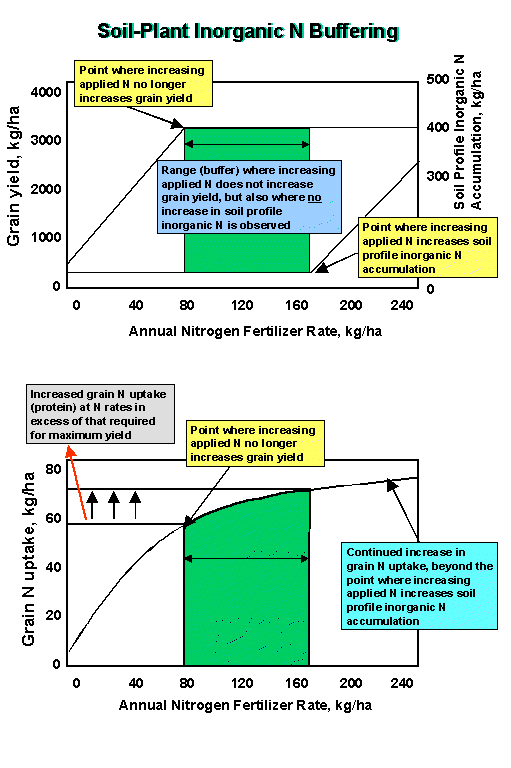Definition: Ability of the soil-plant
system to limit the amount of inorganic N
accumulation in the rooting profile when N fertilization rates exceed that
required for maximum grain yields.
Nitrogen Buffering Mechanisms
(N in excess of that needed for maximum yield)
Plant NH3 loss increases with higher rates of applied N
Increased forage N
Increased organic C
Increased grain protein
Increased denitrification
Increased volatilization (urea)

Conclusions:
- Nitrogen fertilization rates which
significantly increased inorganic
profile N accumulation, exceeded that required for maximum
yields by more than 20 kg N ha-1 in all experiments. - Soil organic matter levels increased when
N rates exceeded that
required for maximum yield - Use of fertilizer N at rates equal or
less than that required to meet crop
needs did not increase inorganic N accumulation - Research results have documented increased
- plant N loss
- grain protein
- denitrification
- soil organic C
- forage/straw N
when N rates exceed that required for maximum yield.
- Soil-plant inorganic N buffering is
present in all production systems
but is unlikely to be important when N rates continuously exceed twice that required
References:
Johnson, G.V., and W.R. Raun. 1995. Nitrate leaching in continuous winter wheat: use of a soil-plant buffering concept to account for fertilizer nitrogen. J. Prod. Agric. 8:486-491.
Raun, W.R., and G.V. Johnson. 1995. Soil-plant buffering of inorganic nitrogen in continuous winter wheat. Agron. J. 87:827-834.
Westerman, R.L, R.K. Boman, W.R. Raun and G.V. Johnson. 1994. Ammonium and nitrate nitrogen in soil profiles of long-term winter wheat fertilization experiments. Agron. J. 86:94-99.
Westfall, D.G., J.L. Havlin, G.W. Hergert and W.R. Raun. 1996. Nitrogen management in dryland cropping systems. J. Prod. Agric. 9:192-199.